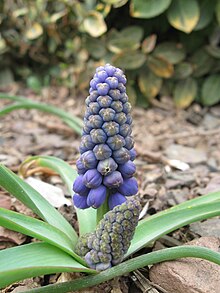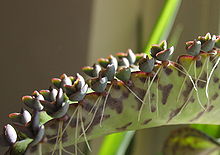Vegetative reproduction
Vegetative reproduction is a kind of asexual reproduction.[1][2] Many plants do it. By vegetative reproduction plants can cover the ground quickly: ground taken by one plant is difficult for other plants to take. This occurs naturally, and can also be done on purpose by horticulturists.


Vegetative reproduction uses mitosis. This means that the newly created cell is a clone, and identical to the parent cell. Some plants put out new roots underground, have bulbs, or grow new vines and shoots above ground.
By this process, new plants can be grown naturally without any seeds or spores. Therefore, it is widely used especially in agriculture to spread the trees that are of great value to the economy.
Cuttings
changeIn gardening and farming, vegetative reproduction means cutting a tree branch below its center joint, planting it in some other earth, and letting it form new roots. In this way, many kinds of useful plants can be easily reproduced without any seeds, for example: apple, avocado, banana, cacao, hemp, orange/lemon, date, fig, grape, almond, pineapple, potato, strawberry, sugar cane and tea.
Related pages
changeReferences
change- ↑ "Vegetative reproduction: definition and examples - Biology Online Dictionary". Biology Articles, Tutorials & Dictionary Online. Retrieved 2020-08-25.
- ↑ "Vegetative plant propagation". Science Learning Hub. Retrieved 2020-08-25.